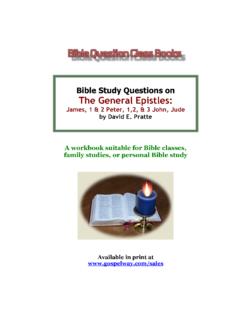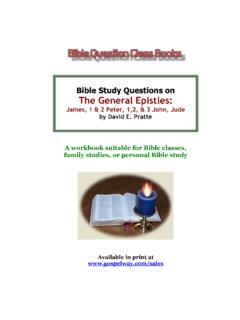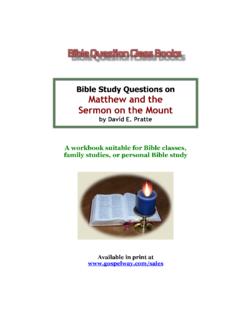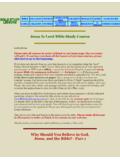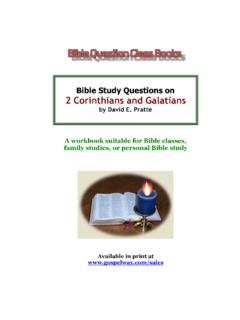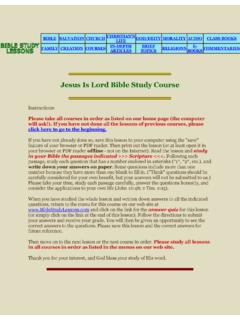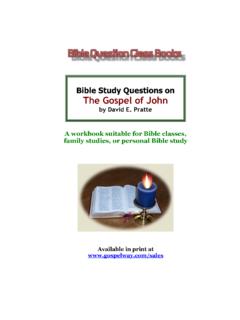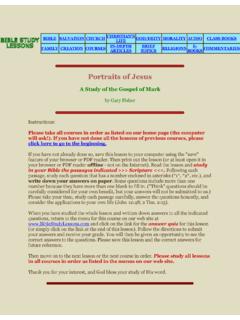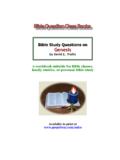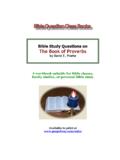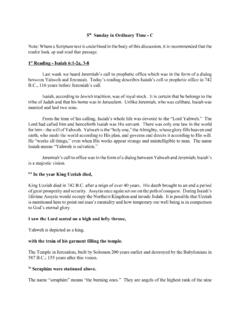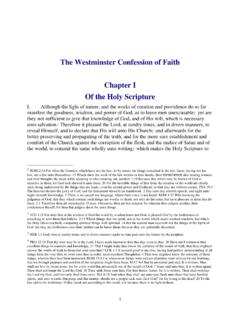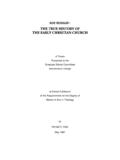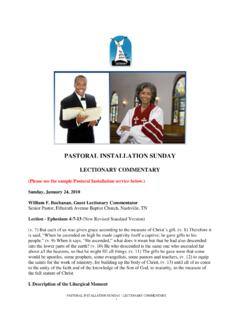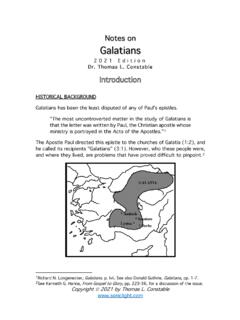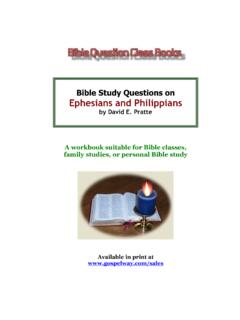Transcription of Commentary on 1 Peter - Bible Study Lessons
1 Page #1 April 7, 2020 Commentary on 1 Peter Bible Study Notes and Comments by David E. Pratte For other free Bible Commentary Study notes, please visit For Study questions on various books of the Bible , see our web site at Copyright 2016 Page #2 April 7, 2020 Comments on the Book of 1 Peter by David E. Pratte Table of Contents Introduction to 1 Peter3 1 Peter 17 1 Peter 225 1 Peter 344 1 Peter 461 1 Peter 573 Copyright David E. Pratte, April 7, 2020, (See end of the file for further copyright information.) Notes to the reader: I have chosen not to include the Bible text in these notes (please use your Bible to follow along). Instead, I have divided the notes by groups of verses; each group of verses begins with a numbered Study question or questions for you to consider. The abbreviation b/c/v means book, chapter, and verse. Also, when I ask the reader to refer to a map, please consult the maps at the back of your Bible or in a Bible dictionary.
2 Unless otherwise indicated, Scripture quotations are generally from the New King james Version (NKJV), copyright 1982, 1988 by Thomas Nelson, Inc. used by permission. All rights reserved. Scripture quotations marked (NASB) are from Holy Bible , New American Standard La Habra, CA: The Lockman Foundation, 1995. Scripture quotations marked (ESV) are from The Holy Bible , English Standard Version, copyright 2001 by Crossway Bibles, a publishing ministry of Good News Publishers. Used by permission. All rights reserved. Scripture quotations marked (MLV) are from Modern Literal Version of The New Testament, Copyright 1999 by G. Allen Walker. Scripture quotations marked (NRSV) are from the New Revised Standard Version of the Bible , copyright 1989 by the Division of Christian Education, National Council of the Churches of Christ in the United States of America. Scripture quotations marked (NIV) are from the New International Version of the Holy Bible , copyright 1978 by Zondervan Bible publishers, Grand Rapids, Michigan.
3 Scripture quotations marked (HCSB) are from the Holman Christian Standard Bible , copyright 2008 by Holman Bible publishers, Nashville, Tennessee. Page #3 April 7, 2020 Introduction to 1 Peter Author The inspired author was Peter the apostle (1:1). The book is largely undisputed in authorship or canonicity. Horne states: The genuineness and canonical authority of the first Epistle of Peter have never been disputed. It appears to be twice referred to by Clement of Rome; it is twelve times distinctly quoted by Polycarp and is once cited in the Epistle of the churches of Vienne and Lyons. It was received by Theophilus bishop of Antioch, and quoted by Papias, Irenaeus, Clement of Alexandria, and Tertullian; and Eusebius informs us that it was universally acknowledged to be the production of Saint Peter in the fourth century, since which time its authenticity has never been questioned.
4 MacKnight confirms: ..the authenticity of the first [letter of Peter ] was never called in question; being universally acknowledged as Peter s from the very beginning .. Wherefore there can be no doubt that the first epistle of Peter was all along received as an inspired writing, by the whole Christian church. Notes regarding Peter * Peter was also called Simon (Matthew 10:2) and Cephas (John 1:42). He was called Bar-Jonah because his father was named Jonah. * He lived in Bethsaida and later Capernaum John 1:44; Mark 1:21,29. * Peter was originally introduced to Jesus by his brother Andrew, who had been a follower of John the Baptist. Jesus then gave Peter the name of Cephas John 1:40-42. * Peter had been a fisherman before being called to be an apostle; but Jesus called Peter , along with his brother Andrew and his partners james and John, to become fishers of men Luke 5:1-11; Matthew 4:18-22.
5 * Jesus healed Peter s mother-in-law of a fever Matthew 8:14,15. This demonstrates that Peter was a married man (1 Corinthians 9:5). * Peter accompanied Jesus through much of His earthly ministry and, along with james and John, was present for many special events which even other apostles had not attended. These included: the resurrection of the daughter of Jairus (Mark 5:37; Luke 8:51), the Transfiguration (Matthew 17:1ff; Mark 9:22ff; Luke 9:28ff), and Jesus agony in the garden (Matthew 26:36-46; Mark 14:32-42.). * Peter was one of the original twelve apostles sent by Jesus for the specific purpose of testifying that Jesus was raised from the dead Luke 5:1-11; 6:13-15; John 15:27; Acts 1:8. * He attempted to walk on the water in imitation of Jesus, but after an initial success his faith failed Matthew 14:28-31. * He received no formal religious training in established schools Acts 4:13.
6 * At the arrest of Jesus, Peter attempted to defend Him. He used his sword to cut off the ear of a servant of the high priest John 18:10,11. Jesus rebuked Peter and restored the man s ear. * As predicted by Jesus, Peter denied Jesus three times while Jesus was being tried by the Jews Matthew 26:33,69-75. * He was one of the first to enter Jesus tomb and see that the body was not there after the resurrection. Jesus later expressly appeared to him John 20:1-10; 1 Corinthians 15:5. * He played a leading role in the selection of Matthias to take the place of Judas as an apostle Acts 1:15-26. * Like all the apostles, he received the power of the Holy Spirit to directly guide him in his teaching and to empower him to do miracles John 16:13; Acts 2. Specifically, Peter s mission was mainly to Jews Galatians 2:7. Page #4 April 7, 2020 * He was always known for being impetuous and outspoken, a characteristic which sometimes got him into trouble but sometimes led to great statements of faith Matthew 16:15-18; John 6:68,69.
7 * Despite his failings, Jesus chose him to be the first to preach the gospel to the Jews and the first to preach to the Gentiles Matthew 16:18,19; Acts 2; Acts 10. * Though he was a great and good man in many ways, there is absolutely no truth to the Catholic claim that he was the first Pope or the head or foundation of the church. Jesus Himself is the head of all things to the church (Ephesians 1:22,23). Jesus is only foundation of the church (1 Corinthians 3:11). Ones addressed Those addressed were pilgrims of the dispersion in the areas of Pontus, Galatia, Cappadocia, Asia, and Bithynia (1:1). The geographical areas named are all regions in Asia Minor (see map). Pilgrims are sojourners (ASV), those who reside as aliens (NASB), or strangers (KJV). They are people who live in a place away from their own native country (Hebrews 11:13; 1 Peter 2:11). The term can also refer in a spiritual sense to people to whom Heaven is their real country and they sojourn on earth (compare Hebrews 11:13-16).
8 The dispersion sometimes refers to the Jews who were scattered among the nations when they went into captivity (Deuteronomy 28:25; Jeremiah 34:17). So, some believe that Peter wrote to Jewish Christians. Horne points out that Peter was primarily an apostle to the Jews. In 1 Peter 1:18 Peter states that the recipients had been redeemed from the vain conversation received by tradition from their fathers, which would be typical of Jewish converts. And 2:9 refers to them as a chosen generation, a royal priesthood, a holy nation, and a peculiar people, all of which were terms for the people of Israel in the Old Testament. So this view holds that, having become Christians, the Jewish people addressed became part of the true Israel of God. However, 1:14; 4:3,4 indicate that the recipients had lived in a Gentile manner prior to their conversion (note especially the reference to idolatry).
9 This would seem to indicate a broader reference than just to Jewish Christians. Some might think it refers to the Christians scattered in Acts 8:1-4; but that does not fit because they went only as far as Antioch (11:19), not the places listed here. A more likely view is that the reference is to Christians viewed as citizens of Heaven (Philippians 3:20) but who are pilgrims on earth, comparable to the Jews who had been scattered among the Gentiles. This would be confirmed by the fact that the regions described are all primarily in Gentile territory, and the churches there consisted primarily of Gentiles. Why write a letter to Christians in primarily Gentile regions but address only the Jewish Christians who would be a minority there? In any case, the important point to remember is that Peter was addressing suffering Christians who needed encouragement in the time of hardship.
10 Time of writing There is no indication whatever in the book regarding when it was written, and the date is of no great importance. Most scholars place it in the AD 60s. It was almost surely written before the destruction of Jerusalem. Place of writing As he wrote, Peter said that he was in Babylon (5:13). This could be the literal city of Babylon on the Euphrates river. But some say it figuratively represents Rome. Rome was the capital of the world at this time (like Babylon had been in the past). Peter might have referred to it figuratively knowing Christians would understand but other readers might not (thereby avoiding persecution). It is apparent from the text of the book that the people were facing persecution. Contrary to the Catholic view, however, there is no evidence anywhere else in the Scriptures that Peter was ever in Rome. He surely was not there when Paul wrote his letters to the church in Page #5 April 7, 2020 Rome or from the prison in Rome, since Peter is not mentioned in any of those letters.
